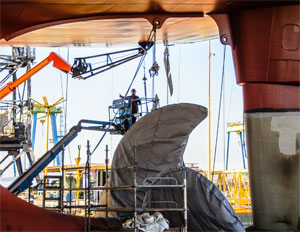What goes up must come down.
For North American shipbuilders, it’s an axiom that has proven itself time and again. So when the global oil market began to collapse in the fall of 2014, the anxiety of many was tempered with a “been there, done that” attitude. This kind of storm has been weathered before and it can be weathered again — even along the Gulf Coast, where just about every commercial newbuild owes its existence to the quest for petroleum.
But as fall turned to winter and winter gave way to spring, the bottom for oil was nowhere in sight. One hundred dollars a barrel gave way to $80 and then $60, and still the skid continued. When prices slipped under $50 and threatened to stay there amid strong output and lackluster demand, a sobering question emerged: Is this the new normal?
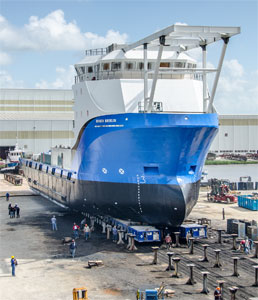 |
|
Brandon Bordelon from Bordelon Marine was among the support vessels launched by Gulf Coast shipyards in 2015. |
|
Brian Gauvin |
In the fickle world of energy, it’s difficult to know. The price doldrums triggered by the 2008 recession were followed by a market rebound, the U.S. shale fracking boom and expanded deepwater exploration. That buoyed the domestic shipbuilding industry, which a year ago was humming with commercial work, especially along the Gulf.
The picture was different in the summer of 2015. As the price of crude plummeted through the first half of the year, oil companies cut spending. Demand for offshore supply vessels, jackup rigs and crew boats suffered accordingly, with vessel utilization rates tanking in the shallow-water and midwater segments. Orders for newbuilds also dried up, leaving shipyards to bank on their pre-crash backlogs to carry them through to better days.
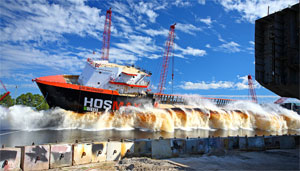 |
|
Eastern Shipbuilding Group continues to launch OSVs for Hornbeck Offshore Services, including HOS Briarwood, in October 2014. |
|
Courtesy Eastern Shipbuilding Group |
A glimmer in the gloom is the realization that this isn’t the industry’s first roller-coaster ride. While there is obvious economic pain in an oil market downturn of this magnitude, a lot of shipyards are better positioned to handle it than they were in the past, said Matt Paxton, president of the Shipbuilders Council of America.
“They have invested, they’ve capitalized their shipyards and they have diversified,” Paxton told American Ship Review. “These shipyards are going to be able to weather these periods better than decades ago when we were focused singlemindedly on one aspect of the industry. This applies not just on the Gulf Coast but also in Virginia and the East Coast and up in the Pacific Northwest and the West Coast. A lot of these shipyards have figured out that they can play in various markets of the industry and be effective.”
More than one basket
The diversification can be broken down into a quad chart of activity: government newbuilds, commercial newbuilds, government repair and commercial repair. Paxton said a lot of U.S. shipyards are becoming involved in all four categories, or at least in a couple of them.
 |
|
A worker at Gulf Craft in Franklin, La., sandblasts the superstructure of a 205-foot fast supply vessel for Seacor Marine. |
|
Brian Gauvin |
“You just don’t have shipbuilders doing one thing anymore,” he said. “That allows you to do more things and to make adjustments. It doesn’t necessarily apply to the really big yards, because they’re building on an order of scale and are able to work through these things. The positive story is that there have been innovations made at our yards, we have become more capable and we are becoming more diversified to handle what we have witnessed many times over, and that’s a changing market.”
One of the more prominent U.S. shipyards taking that playbook and running with it is General Dynamics NASSCO. During a visit in early June, the San Diego yard was building LNG-powered containerships for TOTE (see the profile on Isla Bella, American Ship Review’s Ship of the Year), ECO tankers for Seacor and American Petroleum Tankers, and a mobile landing platform, USNS Lewis B. Puller, for the U.S. Navy.
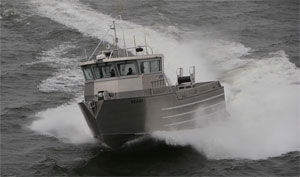 |
|
Kvichak Marine delivered the first of three Bristol Bay gillnetters in April. The 32-footers enhance a portfolio that includes everything from pilot boats to hovercrafts. |
|
Courtesy Kvichak Marine Industries |
While dual-fuel vessels are still in their infancy in North America, liquefied natural gas could be the fuel of the future for many operators. NASSCO is gaining experience in the field with Isla Bella and its sister, Perla del Caribe, and with the ECO tankers, which are designed to accommodate a conversion to LNG. Building ships to export U.S.-produced LNG also could be in the cards.
“Our parent company, General Dynamics, built LNG tankers out of Quincy, Mass., back in the late ’70s,” said Parker Larson, director of commercial programs for NASSCO. “We’d like to pick up where they left off and hopefully one day we’re building Jones Act LNG carriers. For now, it would be nice to be the leader in LNG technology in a broad sense. I think with this project (Isla Bella) we’ve learned a lot about how to do it from a technical perspective, from a construction perspective and from a regulatory perspective.”
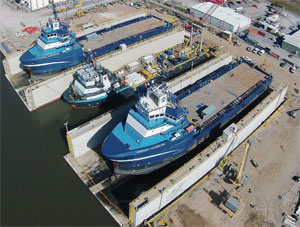 |
|
Bollinger Shipyards’ facility in Port Fourchon, La., has a new 10,500-ton dry dock: Mr. Eric, top, shown taking on its first project, the PSV Harvey Supporter. Another Harvey Gulf PSV, Harvey Champion, is serviced on the dry dock Mr. Paul. Moored between them is Cindy Brown Tide, a Tidewater PSV. |
|
Courtesy Bollinger Shipyards |
Energy exports: A silver lining?
Despite the collapse of oil prices and the subsequent hit on supply vessels and crew boats in the Gulf, there are potential energy-related positives for U.S. shipbuilders. The blossoming LNG export market and a push to repeal the ban on overseas sales of U.S. crude oil could translate into more newbuilds stateside.
According to the Energy Information Administration (EIA), the fracking boom has the United States on track to become a net exporter of natural gas by 2018 and the world’s third-largest exporter of LNG by 2020. U.S. crude oil production is forecast to decrease through mid-2016 before growth resumes late in the year, with production averaging 8.8 million barrels a day.
The question for American shipbuilders is what role U.S.-built, U.S.-flagged vessels might play in the export market for LNG and crude. The answer hinges on the political winds in Washington and whether the Jones Act can withstand challenges from those who would like to see it changed or eliminated.
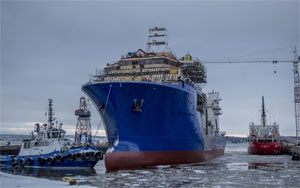 |
|
Quebec’s Davie Shipyard, which made headlines last year with its work on dual-fuel ferries, also launched the subsea construction vessel Cecon Excellence. |
|
Courtesy Chantier Davie Canada |
Jones Act opponents have become more vocal as momentum has grown to lift the ban on crude oil exports. The fate of a bill calling for a repeal, the Offshore Production and Energizing National Security Act of 2015, was uncertain as American Ship Review went to press.
Regardless of the outcome of that battle, Paxton said U.S. shipbuilders would remain busy providing vessels — particularly barges — to transport U.S.-produced oil and petroleum products.
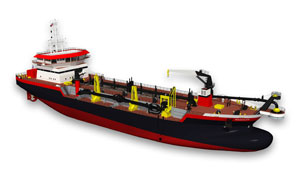 |
|
Eastern Shipbuilding’s diverse order book includes M/V Magdalen, a trailing suction hopper dredger for Weeks Marine. High oil prices or low, there is a need for barges. |
|
Courtesy Eastern Shipbuilding Group |
“There is still strong demand for the tanker market domestically because we’re still going to have to move a lot of this content,” he said. “There’s only so much we can do with our pipelines — our pipeline infrastructure is at its maximum. You see what’s happening with our membership yards like Jeffboat. They just continue to deliver these barges, they continue to push them out.”
American yards also will be ready to deliver if and when the LNG market calls, Paxton said.
“We haven’t built an LNG carrier since the late 1970s or early 1980s,” he said. “Why not? Because we couldn’t do it if there wasn’t a market for it. (The United States) hasn’t been moving LNG. If there is a market, I would think you would see our shipyard industry meet that demand.”
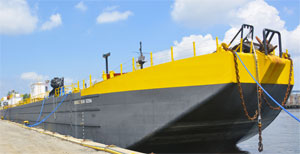 |
|
High oil prices or low, there is a need for barges. Conrad Shipyard delivered Double Skin 509A, a 361-foot asphalt barge, to Vane Brothers in September. |
|
Courtesy Vane Brothers |

